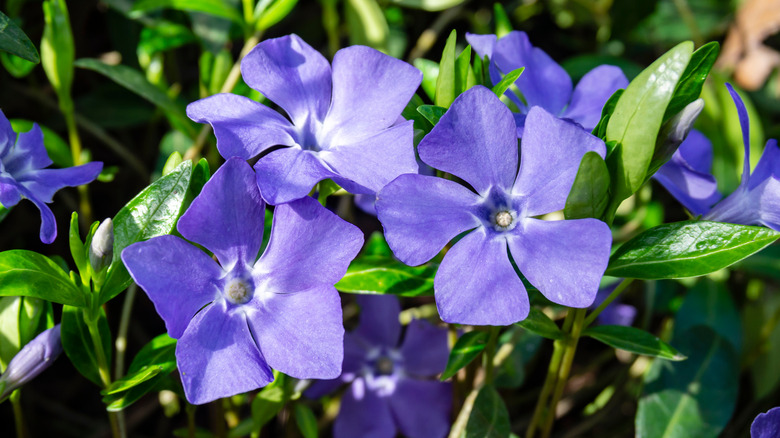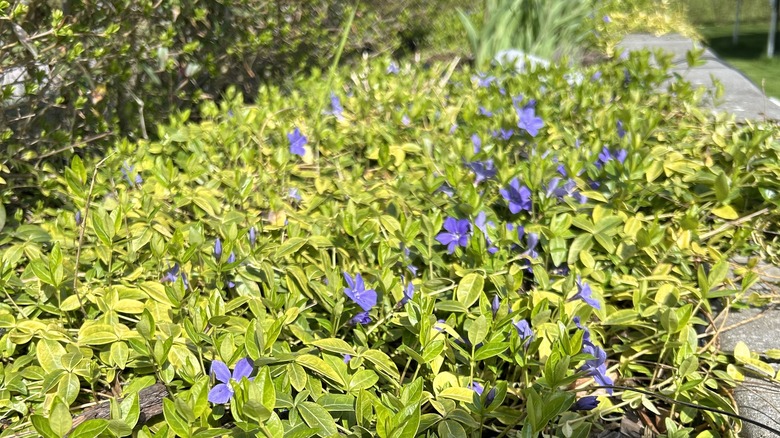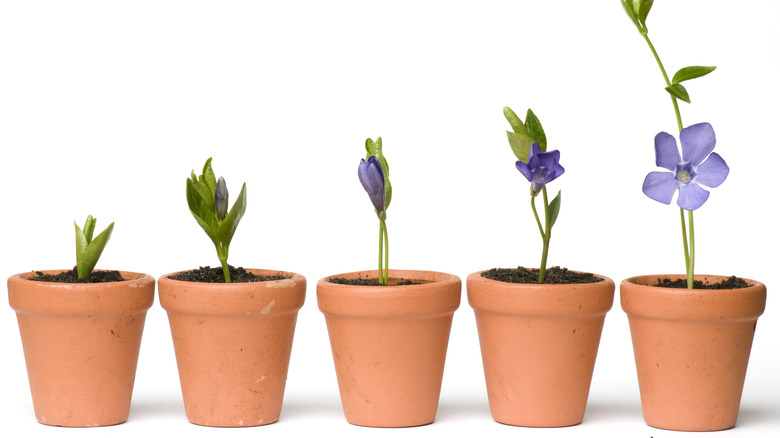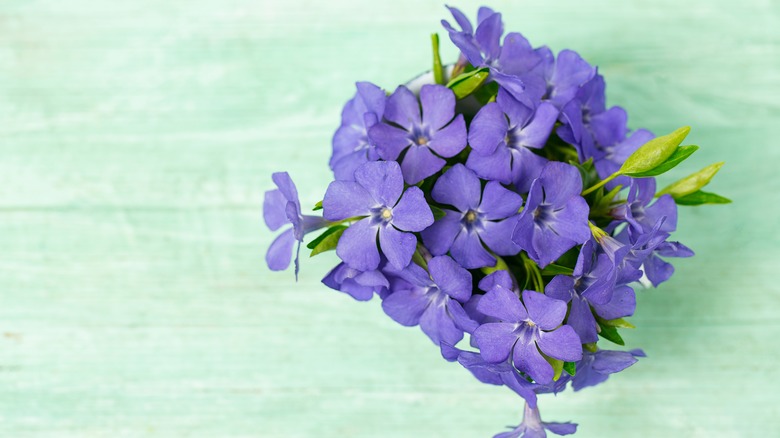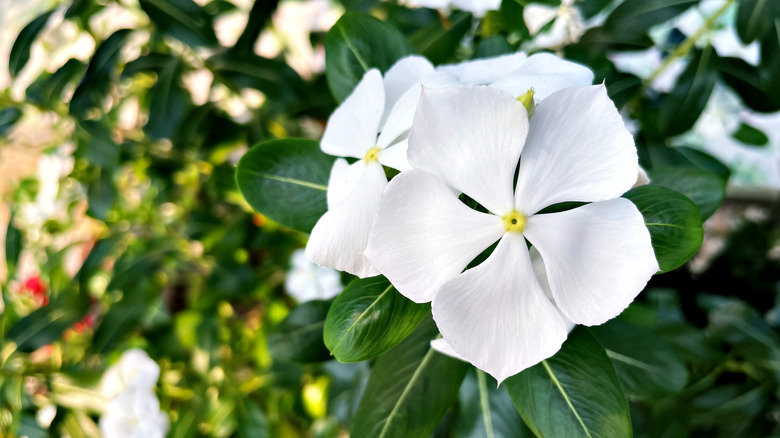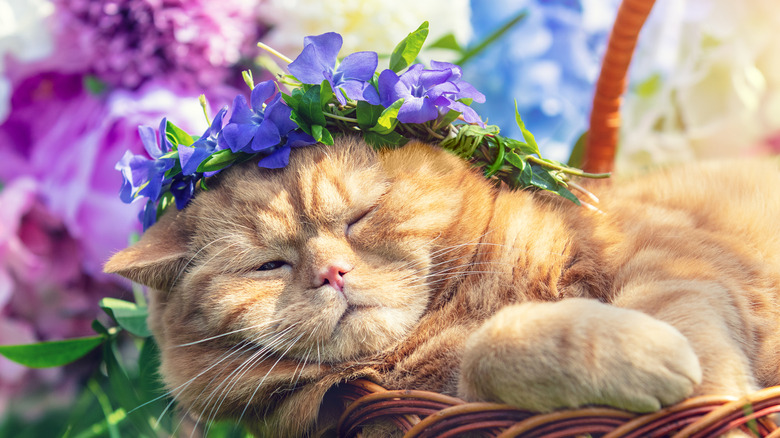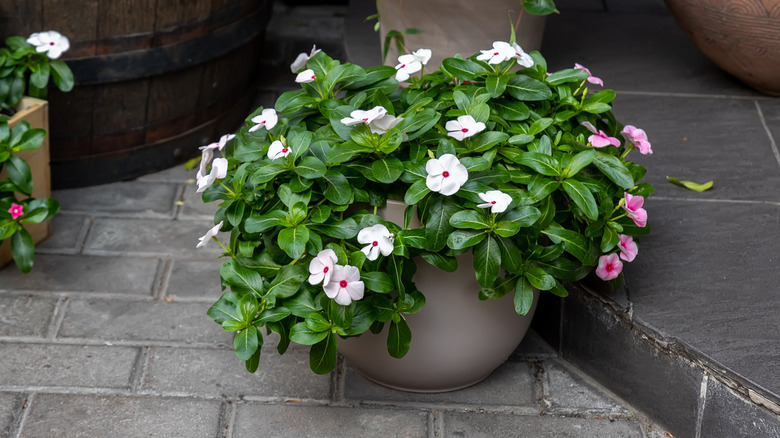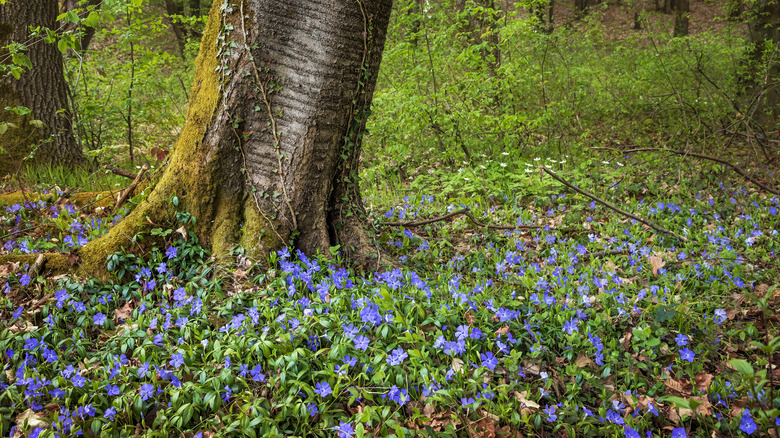How To Care For A Periwinkle Flower
Vinca minor, also known as the periwinkle flower, is most commonly seen growing along hillsides and other steep surfaces. The periwinkle flower is an evergreen plant that spreads widely over the ground with its oval-shaped, ½ to 2-inch-long leaves. They are a deep green color and have a thick, glossy texture. Each leaf is also dense with a milky liquid inside that escapes when the leaf is punctured or broken. The flowers on this plant most commonly appear within the months of spring and can have various colors but are mainly purple, blue, or white. These flowers span between 1 and 2 inches across and grow abundantly in the sunlight (per Clemson).
The Invasive Plant Species Assessment Working Group notes that periwinkle is native to a good portion of Europe, including Switzerland, areas around the Mediterranean, and some northern parts of Africa. When the plant came to the United States, people mainly used it for medicine and other health purposes. However, it was also commonly used in gardens and other outdoor spaces to decorate empty ground spaces and help against erosion. Despite all the benefits of periwinkle, growing the plant must be done cautiously to avoid its tendency to overpower a garden area. If you think the periwinkle flower is the right fit for your garden, look no further because House Digest has everything you need to know to grow and contain your plant.
How to use the periwinkle flower in garden
One of the most functional purposes of periwinkle is its ability to prevent and counteract erosion. SFGate notes that erosion occurs on sloped areas when the soil is consistently pushed off a surface due to extreme weather. Periwinkle can work against and counteract this issue by rooting quickly over the eroded surface and keeping the soil in place.
Periwinkle is also a great plant to use for ground coverage, even in shady areas. Clemson shares that if there is empty space under the trees in your yard, periwinkle flowers can be added as a quick and easy filler and prevent weeds from growing in those places. Some flower species can also thrive beautifully in potted environments, especially in window boxes. When placed in a window box, periwinkle flowers will droop down from the window, adding a colorful, fairytale-like element to your home.
How to grow a periwinkle flower
Growing a periwinkle flower is not a difficult task and can be done easily from its seeds. The seed pods are positioned underneath the flowers when they bloom in the spring. Once removed from the plant, Gardening Know How suggests drying out the pods for easier and safer extraction of the seeds. Once the seeds are extracted for their pod, they should remain in a cool, dry place to replicate a period of dormancy before they are ready to start the germination process. For the best results, Gardening Know How recommends starting periwinkle seed germination indoors, three to four months before spring.
Cover the seeds with a light layer of soil to initiate the germination process and place them in a warm environment; ideally, the temperature should be around 80 degrees Fahrenheit. Because periwinkle seeds need complete darkness to germinate properly, you should also place a damp newspaper over the soil for an added layer of darkness. The seeds should begin to sprout within a week. As soon as they sprout, remove the newspaper and move them to a warm, sunny area. As periwinkle flowers mature, the plant's shoots naturally develop roots as they touch the soil. From that point, the plant can be easily divided into two with a pair of pruners, per Gardeners' World.
How to care for a periwinkle flower
Periwinkle flowers are known for growing naturally and easily in a garden setting. Clemson even mentions that these plants have the luxury of growing in various areas in your garden. The flowers bloom most abundantly in the sunshine, but the foliage thrives in the shade; therefore, it's best to plant your periwinkle flowers in an area where they will receive both sun and shade, The Spruce recommends. These plants can also tolerate a fully shaded position, but you should strictly avoid planting them in full-sun areas due to their burning tendency.
When growing and planting your periwinkle flowers, always use nutrient-rich soil. This flora loves rich soil with tons of minerals, whether from compost or other potting soil mixtures. Periwinkle flowers also need soil that allows them good drainage throughout the year to accommodate the many weather changes during the four seasons. They also love plenty of water, and although they can tolerate dry conditions to some extent, ensure to keep their soil moist to ensure their consistent health and beauty.
Periwinkle flower varieties
Plant Care Today mentions approximately 30 different varieties of periwinkle flowers, all varying in size, color, and shape. The three most common species are Lesser periwinkle (Vinca minor), Big periwinkle (Vinca major), and Catharanthus rosea. Now, let's take a look at some of the varieties of these species.
- White Periwinkle (Vinca minor 'Alba') — This cultivar features gorgeous white flowers in the spring and summertime, which are beautifully contrasted by the deep green leaves that keep their vibrant color year-round, Connon Nurseries explains.
- Wine Periwinkle (Vinca minor 'Atropurpurea') — This variety gets its name from its deep purple flowers. Little Prince says it is a great fit for containers or climbing structures on your porch or home.
- Illumination Periwinkle (Vinca minor 'Illumination') — This plant is known for its unique evergreen foliage, a dark green leafage with splatters of bright yellow in the center of each leaf, per Chalet.
- Moonlit Periwinkle (Vinca minor 'moonlit') — This cultivar can be easily recognized by its ruffled, purple flowers and dark evergreen leaves that are lined with a thin yellow rim, All Season Plants notes.
Is the periwinkle flower toxic?
Depending on the species of periwinkle flower you possess, the range of toxicity can vary. The two main species of periwinkle, Vinca minor and Vinca major, tend to be slightly — if not at all — toxic to humans and animals. Plant Addicts notes that there are compounds within the Catharanthus rosea periwinkle species called alkaloids. These alkaloids are commonly used in various intense medical treatments and medications, for example, diabetes, high blood pressure, and even chemotherapy. However, Plant Care Today states that the Catharanthus rosea species is a very toxic species of periwinkle and can harshly affect the health of both humans and common house pets that consume it.
Signs of periwinkle poisoning can range in severity, but it generally causes vomiting, diarrhea, low blood pressure, depression, and sometimes tremors and seizures. The symptoms for house pets are much less severe than those seen in humans, especially children. Periwinkle poisoning in children can cause stomach cramps, fever, nausea, and headache. Some more severe conditions include nerve damage, cardiac symptoms, hallucinations, reduced blood pressure, or even death, Children's Health and Plant Addicts add. To avoid these risks to you and your family, firmly restrict access to these plants or remove them from your yard altogether.
How to repot a periwinkle flower
The best species of periwinkle to use for your potting needs is Vinca major, also known as Big Periwinkle. Despite its lacking durability compared to its Vinca minor relative, it is a larger and faster-growing version of the periwinkle flower, per Home Stratosphere. This species is better grown in a potted environment, where its beauty can still be enjoyed while posing less of a threat to your garden, SFGate mentions: The potted environment can keep it perfectly restricted and contained. Depending on the size of the pot, multiple periwinkle flowers can be planted in the same container, as long as they receive at least 8 inches of space between each other. Also, ensure your pot has drainage holes at the bottom.
Place the container in an area with partial shade and partial sun. As the periwinkle plants grow, they will cascade down from their restricted environment, rarely needing to be repotted. If you plan on placing your periwinkle flowers in a window box, start by ensuring the container has a proper drainage system and is not located in a full sun position. It's also best to fill the bottom of the container with soil and a slow-releasing fertilizer before placing the periwinkles inside.
How to control your periwinkle flower
Periwinkle flowers are known for being quick-rooting plants because they start developing new roots as soon as one of their shoots touches the soil. Unfortunately, this process can cause you to quickly lose control of the plant, causing many issues for your garden, including the death of other plants in your backyard. There are, however, several different techniques you can use to prevent your periwinkle flowers from overpowering your property or simply get rid of them altogether.
Gardeners' World first suggests cutting the plant back wholly and regularly disposing of loose stems to avoid their quick propagation process. To cease this function, ensure the stems are placed in the garbage, not the compost. The plant's roots should also be dug out of the ground and disposed of properly. Chemical weed killers are also an excellent solution to help the extermination process. Gardeners' World specifically recommends using a systematic weed killer, which only needs to be applied to the leaves before the plant takes over and distributes it throughout the rest of the plant. If you have other plants near your periwinkles, ensure the weed killer is carefully applied to avoid the unnecessary death of different plants in your garden.
